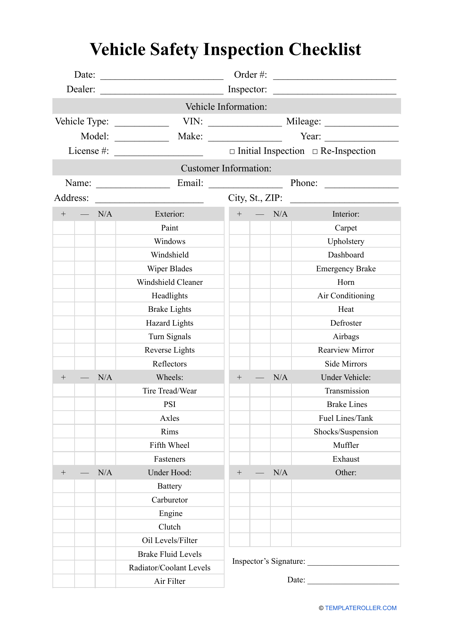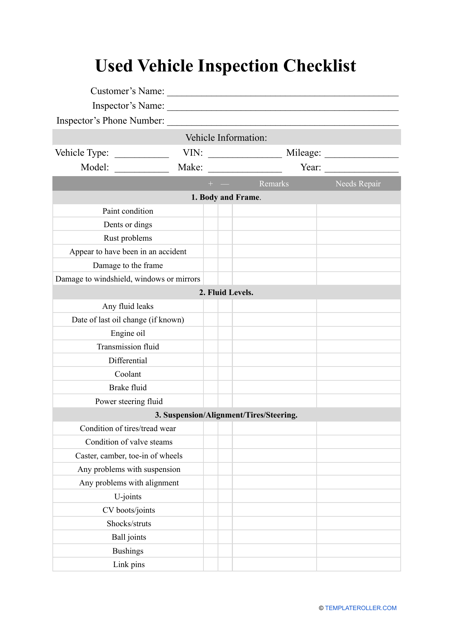Free Vehicle Inspection Checklist Templates
What Is a Vehicle Inspection Checklist?
A Vehicle Inspection Checklist is a document that records the physical and visual inspection of a vehicle before it is used. When you make an issue report you make sure the vehicle is safe to use.
Once the check-up is performed and you have completed the checklist, report any discovered issues to your supervisor or the individual who is responsible for vehicle maintenance. If you have a manufacturer’s guide or vehicle manual, it will help you customize your inspection.
Alternatively, you can browse our library of templates to download the free printable Vehicle Inspection Checklist you need.
At What Point Should Your Daily Vehicle Inspection Checklist Be Performed?
Whether your vehicle is a car, truck, SUV, commercial vehicle, or passenger-carrying vehicle (for instance, a school bus or ambulance), the inspection should be done right before using the vehicle. Perform a pre-operation inspection each time you use the vehicle – for example, at the beginning of a shift or before the first call. You may also complete a Car Inspection Checklist template when conducting regular driver training assessments.
What Is Part of the Daily Vehicle Inspection Checklist?
Follow these steps to create a perfect Vehicle Inspection Checklist:
- Enter the vehicle inspector's details (the full name of the inspection agency and its location). Indicate the date and time of the car inspection.
- Record the vehicle operator's details. This is optional (depending on the type of inspection and vehicle), however when possible, you should link the operator and car together. Record the operator's full name, phone number, address, and driving license number. Verify that the operator has valid insurance.
- Describe the vehicle - write down its type, make and model, year, license plate number, and mileage.
- Test all parts of the car and record the results:
- Find out if the brakes are in good condition. Test the emergency brake;
- Check the front and rear bumpers and record their condition;
- Use the horn a couple of times to verify it works and is loud enough;
- Inspect the seat belts as they are one of the core safety measures;
- Make sure the front and rear defrosters works;
- Turn the heating on and feel its effects;
- Check the emergency equipment and find out which emergency supplies the vehicle has. Usually, a vehicle should be equipped with a first aid kit, warning triangle, flashlight, and a fire extinguisher;
- Check out the headlights, tail lights, brake lights, turn signals, and reversing lights;
- Inspect the outside and inside mirrors - they must be properly adjusted and the road behind the vehicle must be visible;
- Make sure the tires match the wheels. Check the tire condition and wheel alignment. Do not forget to inspect the spare tire;
- Check the engine oil quality and level;
- Examine the car battery - its physical condition and color indicator;
- Record the state of the windshield and measure the windshield washer fluid;
- Make sure all of the windows are in good condition. Pay attention to the rear window and the window controls;
- Inspect the windshield wipers.
- As a final step, you should give the vehicle an inspection verdict. State if the vehicle passed or failed the inspection;
- Sign the document.
Once the inspection is performed and you completed and signed the checklist, let the vehicle owner or operator know its results and describe what work needs to be done if you discovered any issues.
Not what you were looking for? Browse more forms below:
Documents:
3
An individual may use this type of template would like to have their vehicle inspected for safety purposes.
If you need to make sure a car that had one or more owners in the past meets the safety regulations, fill out this document to report the issues you find or confirm the vehicle can be used immediately.
The purpose of this document is to gather all of the information about the condition of a commercial vehicle and ensure it is ready to be operated.



